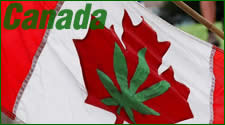 Many things are falling into place as Canada advances toward legal cannabis, expected to take effect this summer. Provinces are to come up with their own policies on regulation, and these are now congealing. The government of Nova Scotia has agreed on a plan to market retail cannabis at liquor stores through the provincial public company that now maintains a monopoly on alcohol sales, the Canadian Broadcasting Company reports. At the other end of the continent, British Columbia is also said to be considering such a plan.
Many things are falling into place as Canada advances toward legal cannabis, expected to take effect this summer. Provinces are to come up with their own policies on regulation, and these are now congealing. The government of Nova Scotia has agreed on a plan to market retail cannabis at liquor stores through the provincial public company that now maintains a monopoly on alcohol sales, the Canadian Broadcasting Company reports. At the other end of the continent, British Columbia is also said to be considering such a plan.
According to a study by the Denver-based Marijuana Policy Group, Canada’s publicly traded licensed producers are on track to bankroll capacity to produce over 1.25 million kilograms (1,370 tons) of cannabis slated to come online between this year and 2019. Marijuana Business Daily finds that this will be more than enough to meet national demand, although there may be shortages in some regions due to problems of unequal distribution.
One question localities are still grappling with is whether a massive conversion of farmland to cannabis cultivation will be permitted. The Vancouver Courier reports that the city council of Richmond, British Columbia, has resolved to make a recommendation to the provincial and federal governments not to allow use of farmland for cannabis production in the municipality. The Jan. 8 resolution followed a heated discussion in the council chamber.
Council member Alexa Loo dissented from the resolution, arguing that growing cannabis on farmland could be a good way to keep agriculture profitable, as well as preserving the soil—as opposed to allowing real estate developers to build mansions on it.
A majority of councilors, however, insisted that cannabis production should be considered an industrial activity, and confined to areas zoned for that. "Basically they think the standard [for legal cannabis] should be what we already set in place ourselves for medical marijuana," said Ted Townsend, a spokesperson for the city.
Richmond is actually a suburb of Vancouver, but has a certain amount of farmland set away as an Agricultural Land Reserve—part of a provincial program to protect farms from encroaching development. And this program is now threatened. A CBC report notes that the future of 4.6 million hectares of these provincially protected farmlands—an area bigger than Denmark and almost five percent of BC's total area—is up for review. BC Agriculture Minister Lana Popham announced Jan. 4 that an independent commission will hold consultations across the province on "revitalization" of the the reserve program. There are fears the program could be eroded to allow real-estate development within the reserves.
The previous provincial government actually started this process in 2014, opening reserve lands in the North, the Kootenays and parts of the Interior to non-farm uses, while keeping the Lower Mainland, Fraser Valley, Okanagan Valley and Vancouver Island lands restricted.
The resistance to massively opening farmland to cannabis comes from multiple sectors. Cultural conservatism and the narco-stigma are obvious factors. But there are others. When the new regs for legal cannabis were unveiled in California, many avid supporters of the herb were bitterly disappointed that there were no provisions limiting the total acreage of a single production unit, or the number of cultivation licenses one entity can hold. This omission raised fears of corporate cannabis, with agribusiness poised to squeeze traditional small growers off the market.
But cannabis could also be a critical ticket to saving farmland from corporate bulldozers, giving farmers the financial muscle to resist pressure to sell out. It will be instructive to see how authorities finesse this dilemma as the legal market takes hold in California and Canada alike.
Cross-post to High Times
Photo by PhotoPhreak







Recent comments
1 week 6 days ago
5 weeks 4 days ago
9 weeks 5 days ago
10 weeks 3 days ago
20 weeks 3 days ago
24 weeks 3 days ago
25 weeks 4 days ago
25 weeks 4 days ago
46 weeks 4 days ago
50 weeks 5 days ago